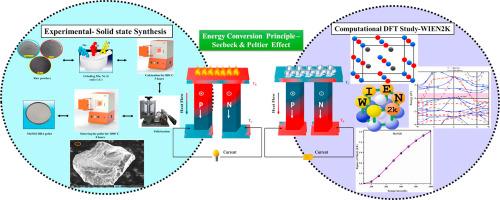MnNiSi半赫斯勒合金:能量收集和自旋电子应用的计算和实验见解
IF 4.3
Q2 CHEMISTRY, PHYSICAL
引用次数: 0
摘要
MnNiSi半heusler合金是通过热电和自旋电子的固态合成方法合成的,并通过各种技术进行了广泛的表征。x射线衍射(XRD)证实该合金具有3个互穿面心立方亚晶格的立方晶体结构,晶格参数为5.1592 Å。场发射扫描电子显微镜(FE-SEM)显示出具有不同形状和大小晶粒的多晶性质,而能量色散x射线光谱(EDX)证实了成分的均匀性。利用紫外可见光谱进行光学表征,在278 nm处发现了一个宽吸收峰,从tac图中计算出光学带隙能(Eg)为0.57 eV,表明其具有半导体行为。傅里叶变换红外光谱(FTIR)强调与有机和无机成分相关的振动模式。力学分析表明,在Debye温度和熔点分别为505 K和1244 K时具有稳定性。MnNiSi半heusler的磁性特征证明了材料的铁磁性(FM)行为。热电性能评价表明,该材料的塞贝克系数为118 μ V/K,电导率为1.08 × 103 Ω-1m-1,导热系数为2.18 W/mK,功率因数为15.27 × 10-3W /mK2。这些性质产生了1.52的无因次优值(ZT),突出了MnNiSi作为热电能量转换应用的有前途的候选者。本文章由计算机程序翻译,如有差异,请以英文原文为准。

MnNiSi Half-Heusler Alloy: Computational and experimental insights for energy harvesting and spintronic applications
The MnNiSi half-Heusler alloy was synthesized via solid-state synthesis for thermoelectric and spintronic applications and extensively characterized using various techniques. X-ray diffraction (XRD) confirmed the alloy's cubic crystal structure with three interpenetrating face-centered cubic sublattices and a lattice parameter of 5.1592 Å. Field emission scanning electron microscopy (FE-SEM) revealed a polycrystalline nature with grains of varying shapes and sizes, while energy-dispersive X-ray spectroscopy (EDX) verified compositional homogeneity. Optical characterization using UV–Vis spectroscopy identified a broad absorption peak at 278 nm, and the optical bandgap energy (Eg) was calculated as 0.57 eV from the Tauc plot, indicating semiconducting behaviour. Fourier-transform infrared (FTIR) spectroscopy highlighted vibrational modes associated with organic and inorganic components. Mechanical analysis demonstrated stability with Debye and melting temperatures of 505 K and 1244 K, respectively. The magnetic characteristics of the MnNiSi half-Heusler demonstrate the material's Ferromagnetic (FM) behaviour. The thermoelectric evaluation showed a Seebeck coefficient of 118 µV/K, electrical conductivity of 1.08 × 103 Ω-1m-1, a thermal conductivity of 2.18 W/mK, and a power factor of 15.27 × 10–3W/mK2. These properties yielded a dimensionless figure of merit (ZT) of 1.52, highlighting MnNiSi as a promising candidate for thermoelectric energy conversion applications.
求助全文
通过发布文献求助,成功后即可免费获取论文全文。
去求助
来源期刊

Chemical Physics Impact
Materials Science-Materials Science (miscellaneous)
CiteScore
2.60
自引率
0.00%
发文量
65
审稿时长
46 days
 求助内容:
求助内容: 应助结果提醒方式:
应助结果提醒方式:


